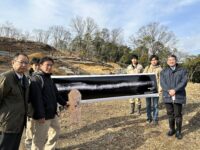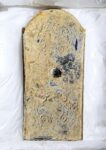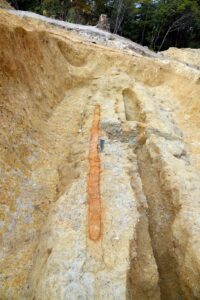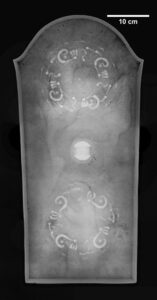 The longest sword in Japan and a large bronze mirror that is also unprecedented in the Japanese archaeological record have been unearthed at the Tomio Maruyama burial mound in Nara. The burial mound (known as a kofun) and artifacts date to the second half of the 4th century.
The longest sword in Japan and a large bronze mirror that is also unprecedented in the Japanese archaeological record have been unearthed at the Tomio Maruyama burial mound in Nara. The burial mound (known as a kofun) and artifacts date to the second half of the 4th century.
The sword is 2.37 meters (7’9″) long and 6 cm (2.34 inches) wide, more than twice as long as the previous record-holder that was found in a late 5th century burial mound in Hiroshima. It is the longest iron sword ever found in East Asia. The sword is a serpentine shape. Only 85 serpentine swords have been unearthed in Japan, and this is the oldest of them. It was hammered and bent in six places to create the characteristic wavy effect. Traces of organic remains from the sheath and grip wrapping were found on the pommel, hilt and scabbard. Its extraordinary dimensions and shape are a testament to the advanced ironworking techniques of the Kofun Period (ca. 250-538 A.D.).
 The bronze mirror is shaped like a shield, a form never before seen in a kofun, and it too is oversized by a lot. It is 64 cm (two feet) long and 31 cm (one foot) wide, making it the largest mirror of the period ever discovered. Its decoration is also unique. The back of the mirror is engraved with stylized dragons and geometric designs. A round projection in the center that looks like a shield boss is called a “chu” and it’s actually a handle. The reflective surface of the mirror is still smooth and polished.
The bronze mirror is shaped like a shield, a form never before seen in a kofun, and it too is oversized by a lot. It is 64 cm (two feet) long and 31 cm (one foot) wide, making it the largest mirror of the period ever discovered. Its decoration is also unique. The back of the mirror is engraved with stylized dragons and geometric designs. A round projection in the center that looks like a shield boss is called a “chu” and it’s actually a handle. The reflective surface of the mirror is still smooth and polished.
The Tomio Maruyama Kofun is the largest circular burial mound in Japan. It is 109 meters (358 feet) in diameter. The site was looted in the Meiji era (1868-1912) and lost its top as well as some of the artifacts it contained. Municipal archaeologists have been studying the mound since 2018, first mapping it with aerial laser scans, then following up with excavation surveys which clarified the structure and dimensions of the mound.
 Last fall was the fifth excavation season which focused on the Tsukuridashi area, a squared outcropping on the northeast side of the mound. Archaeologists found a grave pit that had been dug into a gravel layer before the completion of the burial mound. The grave pit contained a split coffin made of koyamaki (umbrella pine) wood five meters (16.4′) long. It was covered with clay.
Last fall was the fifth excavation season which focused on the Tsukuridashi area, a squared outcropping on the northeast side of the mound. Archaeologists found a grave pit that had been dug into a gravel layer before the completion of the burial mound. The grave pit contained a split coffin made of koyamaki (umbrella pine) wood five meters (16.4′) long. It was covered with clay.
The mirror was placed diagonally against the clay cover with the reflective surface facing outward. The sword was buried flat parallel to the clay cover.
Mirror and shields are considered to be tools to protect the dead from evil spirits. The sword is thought to have been enlarged to increase its power, and the possibility of its use as a battle tool is low, [city archaeologists] said.
The Tomio Maruyama burial mound, the largest in Japan at 109 m in diameter and dating back to the late 4th century, is thought to have belonged to a powerful individual supporting the Yamato rulers of the time.
The burial chamber where the discoveries were made is thought to have belonged to someone close to that person, according to Naohiro Toyoshima, an archaeology professor at Nara University. He also said that the ritualistic sword and the shield-shaped mirror may indicate that the individual was involved in military and ritualistic matters.

